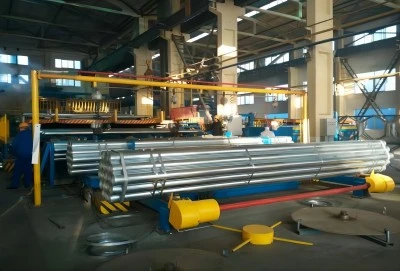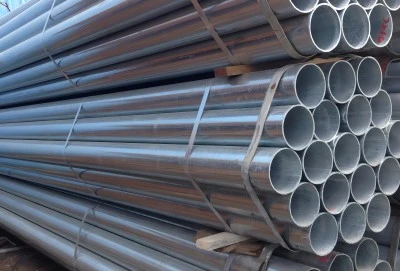Galvanized mild steel pipes have long been a staple in various industries, from oil and gas transportation to water supply systems. Their durability and corrosion resistance make them a popular choice for pipeline engineers and project managers worldwide. However, as environmental concerns grow, it's crucial to examine the eco-friendliness of these ubiquitous materials. While galvanized steel pipes offer excellent longevity and recyclability, their production process does have environmental implications. The zinc coating that provides corrosion protection comes with its own ecological footprint, and the energy-intensive galvanization process raises questions about sustainability. Let's dive deeper into the environmental aspects of galvanized steel piping to understand its true impact.
|
|
|
Environmental impact of galvanized pipe production
Energy consumption in galvanization process
The galvanization process, which gives mild steel pipes their protective zinc coating, is an energy-intensive procedure. It involves heating large furnaces to temperatures exceeding 450°C (842°F), consuming significant amounts of energy. This high energy demand often relies on fossil fuels, contributing to greenhouse gas emissions. However, many modern galvanizing plants are implementing energy-efficient technologies and practices to reduce their carbon footprint. These include heat recovery systems, which capture and reuse excess heat from the galvanizing process, and the use of renewable energy sources to power operations.
Zinc mining and its ecological footprint
The production of galvanized steel pipes begins with zinc mining, an activity that can have substantial environmental impacts. Open-pit mining, the most common method for zinc extraction, can lead to habitat destruction and soil erosion. Additionally, the refining process generates waste products that need careful management to prevent environmental contamination. On the positive side, zinc is a naturally occurring element that's essential for life, and its mining is often subject to strict environmental regulations. Moreover, the longevity of galvanized products means less frequent replacement and, consequently, reduced demand for new zinc mining over time.
Emissions from galvanized pipe manufacturing
The manufacturing of galvanized mild steel pipes releases various emissions into the atmosphere. These include particulate matter, volatile organic compounds (VOCs), and metal fumes. While these emissions are regulated in many countries, they still contribute to air pollution and potential health risks for workers and nearby communities. To address these concerns, pipe manufacturers are increasingly adopting advanced filtration systems and closed-loop processes that minimize emissions and waste. Some facilities are also exploring the use of water-based fluxes instead of traditional acid-based ones, further reducing harmful emissions during the galvanization process.
Recycling rates of galvanized steel in construction
One of the most significant environmental advantages of galvanized mild steel pipes is their high recyclability. The construction industry, which extensively uses these pipes, has impressively high recycling rates for steel products. According to the World Steel Association, the global recycling rate for steel from the construction sector exceeds 85%. This high rate of recycling significantly reduces the need for virgin materials and the associated environmental impacts of mining and processing. In many regions, there are well-established collection and recycling systems for construction materials, making it easier for project managers and contractors to ensure that used galvanized pipes are properly recycled at the end of their life cycle.
Challenges in separating zinc coating from steel
While galvanized steel is highly recyclable, the zinc coating does present some challenges in the recycling process. The presence of zinc can affect the quality of recycled steel if not properly managed. However, modern recycling facilities have developed effective methods to handle galvanized steel. These include pyrometallurgical processes that separate the zinc from the steel during melting. The recovered zinc can then be reused in new galvanizing processes or other applications. This closed-loop approach not only addresses the separation challenge but also contributes to the circular economy by keeping valuable materials in use.
Life cycle assessment of galvanized pipe recycling
Life cycle assessments (LCAs) of galvanized steel pipes reveal that their recyclability significantly offsets the initial environmental impacts of production. The energy saved by recycling steel instead of producing it from raw materials is substantial, with estimates suggesting up to 60% energy savings. Additionally, the zinc coating, once separated, can be recycled indefinitely without losing its chemical or physical properties. This means that the environmental cost of the initial zinc mining and processing can be spread over multiple product lifecycles. For plant equipment managers and procurement professionals, understanding these lifecycle benefits can inform more sustainable purchasing decisions.
Sustainable alternatives to galvanized piping
Eco-friendly coatings for corrosion resistanceAs the industry evolves, new eco-friendly coatings are emerging as potential alternatives to traditional galvanization. These include thermal spray coatings, powder coatings, and nano-coatings that offer corrosion resistance with potentially lower environmental impacts. Some of these alternatives use less energy in their application process and avoid the use of heavy metals. For example, certain ceramic-based coatings provide excellent corrosion protection while being inert and non-toxic. However, it's important to note that these alternatives often come with their own set of environmental considerations and may not match the long-term performance of galvanized coatings in all applications.
Stainless steel as a long-lasting pipe option
Stainless steel pipes are often considered as an alternative to galvanized mild steel pipes, especially in corrosive environments. While the initial production of stainless steel is more energy-intensive than that of galvanized steel, its exceptional durability and corrosion resistance can lead to a longer service life. This extended lifespan can potentially offset the higher initial environmental cost over time. Stainless steel is also highly recyclable, with global recycling rates approaching 90%. For projects in particularly harsh environments, such as offshore platforms or certain industrial applications, the longevity of stainless steel may make it a more sustainable choice in the long run.
Composite materials in modern piping systems
Composite materials, such as fiber-reinforced polymers (FRP), are gaining traction as alternatives to metal pipes in some applications. These materials often have a lower carbon footprint in production compared to steel and offer excellent corrosion resistance without the need for additional coatings. Composites can also be lighter, reducing transportation costs and emissions. However, their recyclability is generally more limited than that of metal pipes, and their long-term performance in certain high-stress applications is still being evaluated. For pipeline engineers considering composite options, it's crucial to assess the specific environmental impacts and performance characteristics for each project.
The eco-friendliness of galvanized mild steel pipes is a complex issue with no simple answer. While their production does have environmental impacts, their durability, corrosion resistance, and high recyclability offer significant sustainability benefits. The long lifespan of galvanized pipes reduces the need for frequent replacements, potentially lowering overall resource consumption. As the industry continues to innovate, improvements in production efficiency and recycling technologies are further enhancing the environmental profile of these pipes. For professionals in oil and gas, water supply, and industrial manufacturing, galvanized mild steel pipes remain a viable option when considering both performance and environmental factors in their projects.
China Galvanized Mild Steel Pipe Factory
Hebei Longma Group is your trusted source for high-quality galvanized mild steel pipes. Our products adhere to international standards such as API 5L, ASTM A53, EN10210, and AS/NZS 1163. We offer a wide range of sizes, with outer diameters from 60.3mm to 1422mm and wall thicknesses from 6.02mm to 50.8mm. Our galvanized coatings comply with various standards, including DIN 30670, DIN30678, CSAZ245.20, EN10339, ISO21809-1, AWWAC210, and C213. Whether you're working on oil and gas transportation, water supply systems, or industrial manufacturing projects, our pipes are designed to meet your specific needs. With our global reach, we serve markets worldwide, with particular expertise in the Middle East, Australia, and Southeast Asia. Experience the Longma difference in quality, durability, and eco-conscious manufacturing. To discuss your project requirements or request a quote, contact us at info@longma-group.com.














